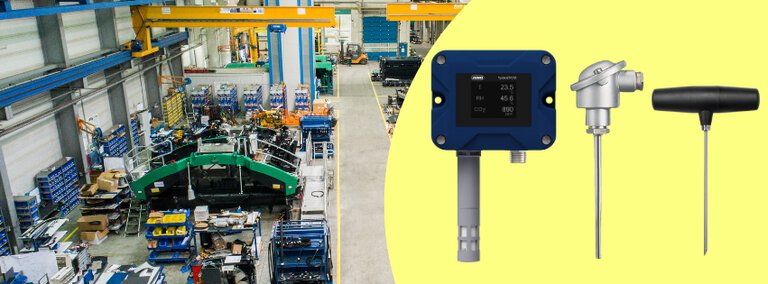

How to monitor the temperature in an autoclave? Case study
In industrial autoclaves, temperature control is essential. If there is too great a difference between the upper and lower parts of the chamber, mechanical deformation may occur, which over time affects the reliability of the device. In many industries, especially those with strict standards, it is therefore necessary not only to measure the temperature precisely, but also to monitor it continuously. In this article, we show how to approach this topic in a structured manner that complies with certification requirements, using the example of a solution designed to work with multiple autoclaves.
Why is measuring temperature differences in an autoclave important?
Uniform temperature distribution in the autoclave chamber is essential for safe and repeatable process operation. In practice, however, there are usually differences between the temperature at the top and the temperature at the bottom of the chamber. If these differences exceed the permissible values, stresses can arise which, over time, lead to deformation of the autoclave structure.
For some processes, such as in the building materials industry, the temperature difference is a factor controlled by certification bodies. Exceeding a certain threshold not only poses a risk of damage, but also means non-compliance with applicable standards. That is why it is so important that temperature differences are constantly monitored and linked to specific system actions, such as alarms, event logging, or light signaling.
Why does too great a temperature difference in the autoclave carry the risk of damaging the material?
During autoclave operation, the material inside the chamber is subjected to high temperature and pressure. It is crucial that the process is uniform, both in terms of time and temperature distribution throughout the working space. If the temperature difference between the top and bottom of the chamber exceeds the permissible values, stresses may arise that affect not only the structure of the device, but also the material being processed.
If one part of the chamber heats up too quickly in relation to another, the material will not expand evenly. This, in turn, can lead to microcracks, deformation, or loss of the required functional properties. In the case of autoclaves used, for example, to dry building materials, even slight deviations from the set parameters can affect the final quality of the product.
For this reason, many processes require strict adherence to the permissible temperature difference – exceeding it is considered a technological hazard that should automatically trigger a response from the control system.
How to monitor temperature in different zones of an autoclave? Measurement methods
Measuring the temperature in an autoclave requires the appropriate placement of sensors at key points in the chamber. Most often, there are two zones: upper (top) and lower (base), between which there may be a significant temperature difference, especially during the heating or cooling phase. It is this difference that determines the thermal stability of the entire process.
Classic resistance sensors (e.g., Pt100) connected to the analog modules of the automation system can be used for measurement. It is important that they are resistant to moisture and high pressure inside the autoclave. The data from the sensors is sent to the controller, which continuously analyzes the temperature in each zone and calculates the difference between them.
A good solution should enable:
- assigning limits for each zone,
- flexible response depending on the current process temperature,
- triggering alarms and recording events when the set thresholds are exceeded.
The more precise the method of measurement and data interpretation, the greater the safety and repeatability of the process – as well as better control over compliance with quality requirements.
How to monitor temperature differences in an autoclave? Our solution
For applications where the temperature difference between the top and bottom of the autoclave affects the quality and safety of the process, a PLC-based system with configurable alarm thresholds works well.
For example, two levels of monitoring can be used:
- The first level is activated when the peak temperature exceeds 110°C and checks that the difference from the base does not exceed 60K.
- The second level is activated above 170°C, with a more restrictive difference threshold, e.g., 30K.
The system should automatically adjust the tolerance threshold depending on the current temperature and switch off monitoring when conditions no longer require supervision (e.g., below 110°C). This can be supplemented by a pre-alarm function that warns when the limit values are approaching.
Modular automation systems with analog inputs, allowing integration with resistive sensors (e.g., Pt100), are ideal for implementing such a solution. Thanks to visualization on operator panels or access via a web browser, operators and service personnel can have a real-time overview of the status of each autoclave.
An additional advantage is the use of light and sound signals, which clearly indicate the operating status of the system – from normal operation, through warning, to alarm.
What are the benefits of automatic temperature monitoring in an autoclave?
The temperature recorder based on the JUMO variTRON 500 system enables precise monitoring of the temperature difference between the top and bottom of the chamber, with automatic response to exceeding the set thresholds. This reduces the risk of mechanical deformation of the autoclave, ensuring a safe and stable process cycle.
Our solution allows for full compliance with the requirements of certification bodies such as TÜV. The ability to set thresholds, record alarms and events, and visualize temperature trends facilitates process documentation and compliance with formal quality requirements.
Another practical benefit is the immediate signaling of the status of each autoclave. Thanks to the use of specialized operator panels and clear light and sound signals, technical personnel have continuous access to information about the status of the system, both locally and remotely. This ensures high accuracy, speeds up the response to any deviations, and minimizes the risk of unplanned downtime.
It is worth noting that our system is scalable and flexible. It can handle multiple autoclaves simultaneously, and its configuration allows alarm thresholds to be adjusted to specific technological requirements. Thanks to its modular design and the possibility of integration with existing measurement infrastructure, implementation does not require a revolution in the plant – and brings a real improvement in the ease of obtaining measurement results and process control.
Would you like to find out how a similar solution could work in your process?
Contact our team – we will advise you and help you choose the right configuration.

This is the image-description
About the author
My name is Natalia and I specialize in content creation. For three years, I have been professionally sculpting words as an editor and copywriter. My mission is to break down even the most complex issues into their basic components. I focus on building relationships with readers and creating experiences. Privately, I am a lover of travel, literature, and fashion.
Your contact person

Comments
We encourage you to leave your comments via the form below. They will be posted online once they have been approved through our review process.


